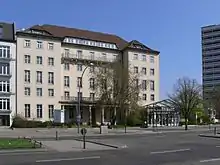Emilie Winkelmann
Emilie Winkelmann (8 May 1875 − 4 August 1951) was the first woman to run an architecture practice in Germany[1] and also the first freelance architect in Germany.[2]

Biography
Winkelmann was born in Aken bei Dessau. She was quite a skilled carpenter[2] which allowed her to get a place to study architecture as a guest student at the College of Technology in Hannover (1902–1908). However, she was refused a diploma as women were not entitled to the qualification until 1909. In 1908, she went to Berlin where she set up her own architecture practice, later employing a staff of up to 15, which included many junior female architects.[3] Before the Second World War, she built some 30 large private houses in and around Berlin as well as the Victoria-Luise girls high school, also known as the Victoria Studienhaus (1915) on Otto-Suhr-Allee. During the war years, not being a member of the National Socialist party, she worked on the restoration of Schloss Grüntal near Bernau. She also contributed to the war effort on the level of diplomacy. After the opening of her office she contributed to a traveling exhibition on “Kurland” (the eastern front) and the House of Friendship (Haus der Freundschaft), the intended future home of the German-Turkish Institute. Unfortunately her design for the House of Friendship never met fruition, as construction was halted by Germany’s defeat.[4] After the war, she participated in reconstruction work until late in life and continued her architectural firm, though her number of clients had significantly declined post-war.[1][5][6] She died at the age of 76 in Hovedissen near Bielefeld.
Selected works
The following are all located in Charlottenburg-Wilmersdorf, Berlin:[7]
- Landhaus Presber (1907–08), Trabener Str. 24
- Landhaus (1908), Lindenallee 21
- Leistikowhaus (1909–10), Leistikowstr. 2
- Ottilie-von-Hansemann-Haus (1914–15), Otto-Suhr-Allee 18-20, first the Victoria Studienhaus school, later the Tribüne theatre.[8]
- Wohnhaus (1925–26), Alemannenallee 3
See also
References
- "Emilie Winkelmann" Archived 2011-05-25 at the Wayback Machine, Berlinische Galerie. Retrieved 9 February 2012.
- "Frauenorte Brandenburg | Emilie Winkelmann". www.frauenorte-brandenburg.de. Retrieved 2016-03-08.
- Stratigakos, Despina (December 2007). "The Professional Spoils of War: German Women Architects and World War I". Society of Architectural Historians. Journal of the Society of Architectural Historians (66.4): 468. Retrieved December 25, 2018.
- Stratigakos, Despina (December 2007). "The Professional Spoils of War: German Women Architects and World War I". Society of Architectural Historians. Journal of the Society of Architectural Historians (66.4): 468. Retrieved 25 December 2018.
- Stratigakos, Despina (December 2007). "The Professional Spoils of War: German Women Architects and World War I". Society of Architectural Historians. Journal of the Society of Architectural Historians (66.4): 473. Retrieved 25 December 2018.
- "Winkelmann, Emilie", Berliner Bezirkslexikon. (in German) Retrieved 9 February 2012.
- "Emilie Winkelmann, Architektin" Archived 2014-01-10 at the Wayback Machine, Lexikon: Charlottenburg-Wilmersdorf von A bis Z. (in German) Retrieved 9 February 2012
- "Tribüne", Berlin Charlottenburg. (in German) Retrieved 9 February 2012.
Literature
- Sonia Ricon Baldessani: Wie Frauen bauen. Architektinnen. Von Julia Morgan bis Zaha Hadid. AvivA Verlag, Berlin, 2001. ISBN 3-932338-12-X; pp. 24–33.
- Kerstin Dörhöfer: Pionierinnen in der Architektur. Eine Baugeschichte der Moderne. Wasmuth Verlag, Tübingen 2004, ISBN 3 8030 0639 2
- Jürgen Schröder: Deutschlands erste Architektin. Emilie Winkelmann baute auch in Vorpommern. In: Heimatkurier. Supplement to Nordkurier, 24 July 2006, p. 24.